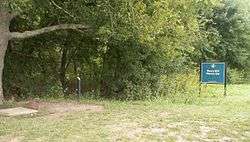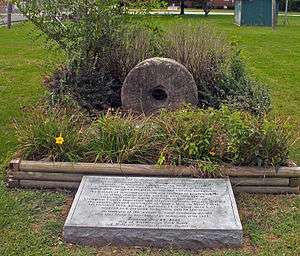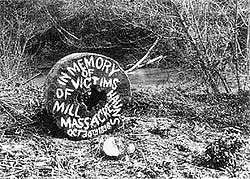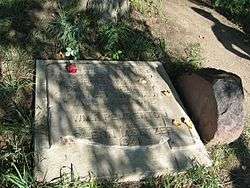Haun's Mill massacre
| Haun's Mill massacre | |
|---|---|
 "Haun's Mill" by C.C.A. Christensen | |
| Location | Fairview township in eastern Caldwell County, Missouri |
| Coordinates | 39°40′13″N 93°50′21″W / 39.670241°N 93.839035°WCoordinates: 39°40′13″N 93°50′21″W / 39.670241°N 93.839035°W |
| Date | October 30, 1838 |
| Weapons | muskets and rifles |
| Deaths | 21 |
Non-fatal injuries | 13, plus 3 of the attackers |
| Perpetrators | ~240 Livingston County Missouri Regulators militiamen and volunteers |




The Haun's Mill massacre was an event in the history of the Latter Day Saint movement. It occurred on October 30, 1838, when a mob/militia unit from Livingston County, Missouri attacked a Mormon settlement in eastern Caldwell County, Missouri, after the Battle of Crooked River.[1] By far the bloodiest event in the 1838 Mormon War in Missouri, it has long been remembered by the members of the Latter Day Saint movement.
Haun's Mill
Haun's Mill was a mill established on the banks of Shoal Creek in Fairview Township, Caldwell County, Missouri in 1835–1836 by Jacob Haun (Hawn), who was not a Mormon.[2][3] However, by October 1838 there were approximately 75 Mormon families living along the banks of Shoal Creek, about 30 of them in the immediate vicinity of Haun's Mill and the blacksmith shop.[4]
Missouri militia
The militia involved in the massacre was led by Colonel William Jennings, Sheriff of Livingston County. At the time of the attack it consisted of 240 men from Daviess, Livingston, Ray, Carroll, and Chariton counties, and included prominent men such as Charles Ashby of the Missouri state legislature and Thomas O. Byron, Clerk of Livingston County.[5]
Although the massacre took place a few days after Missouri's governor, Lilburn Boggs, issued his infamous Missouri Executive Order 44 ("Extermination Order" of 1838), most historians have now concluded that the militia unit had neither the time nor the opportunity to have received news of the order.[6]
Truce
The threat posed by the growing strength and animosity of the Missouri militia caused considerable concern among the Mormon settlers at Haun's Mill. They held a council on Sunday, October 28 and decided to organize a defensive force. 28 men were armed and held in readiness against an attack. That same evening, one of the militia groups sent a representative who negotiated a truce with the settlers. Monday the 29th and most of Tuesday the 30th passed without incident.[5]
Massacre
On October 30 at approximately 4 p.m., the militia rode into the community. David Evans, a leader in the community, ran towards the militia, waving his hat and calling for peace. Alerted to the militia's approach, most of the Latter Day Saint women and children fled into the woods to the south, while most of the men headed to the blacksmith shop. Unfortunately, the building was a particularly vulnerable structure as the widely spaced logs made it easy for the attackers to fire inside. The shop became a deathtrap, since the militia gave no quarter, firing about 100 rifle and musket shots into the building.
After the initial attack, several of those who had been wounded or had surrendered were shot dead. Members of the militia entered the shop and found 10-year-old Sardius Smith, 8-year-old Alma Smith (sons of Amanda Barnes Smith), and 9-year-old Charles Merrick hiding under the blacksmith's bellows. Alma and Charles were shot (Charles later died), and a militia man known as "Glaze, of Carroll county", killed Sardius when he "put his musket against Sardius's skull and blew off the top of his head."[7] Later, a William Reynolds would justify the killing by saying, "Nits will make lice, and if he had lived he would have become a Mormon."[4] Seventy-eight-year-old Thomas McBride surrendered his musket to militiaman Jacob Rogers, who then shot McBride and hacked his body apart with a corn knife. Several other bodies were mutilated, while many women were assaulted. Houses were robbed, wagons, tents, and clothing were stolen, and horses and livestock were driven off, leaving the surviving women and children destitute.
By the end of the massacre at least 17 Mormons were dead: Hiram Abbott, Elias Benner, John Byers, Alexander Campbell, Simon Cox, Josiah Fuller, Austin Hammer, John Lee, Benjamin Lewis, Thomas McBride (78), Charley Merrick (9), Levi Merrick, William Napier, George S. Richards, Sardius Smith (10), Warren Smith (44), and John York. Thirteen more had been injured, including a woman and 9-year-old child. A non-Mormon sympathizer was also killed. Three of the 250 militiamen were wounded, but none fatally. After the massacre, the dead were placed in an unfinished well and covered with dirt and straw. The survivors and their wounded gathered at Far West, Missouri for protection.[5]
Aftermath
After the massacre, Philo Dibble stated that "Brother Joseph had sent word by Haun, who owned the mill, to inform the brethren who were living there to leave and come to Far West, but Mr. Haun did not deliver the message." Of the matter, Joseph Smith recorded, "Up to this day God had given me wisdom to save the people who took counsel. None had ever been killed who abode by my counsel." Then he recorded that innocent lives could have been saved at Haun’s Mill had his counsel been received and followed.[8][9] It appears that Haun had received Joseph Smith's direction to relocate to Far West but did not convey this direction to any of the others at Haun's Mill.[10]
As this and other confrontations unfolded between Mormons and the people in state of Missouri, Mormons appealed for redress from the federal government, accusing the state of Missouri with complicity in violence against Mormons for the state's failure to investigate or prosecute those involved.[11]
Through 2012, the grounds of the massacre were maintained as an historic site by the Community of Christ. In May 2012, it was announced that the The Church of Jesus Christ of Latter-day Saints (LDS Church) had acquired the property and the Far West burying ground from the Community of Christ.[12]
Portrayal in art, entertainment, and media
This event was dramatized in the Latter-day Saint film Legacy: A Mormon Journey (1993).
See also
- Fountain Green massacre
- Latter Day Saint martyrs
- List of massacres in Missouri
- Missouri Executive Order 44
- Mountain Meadows Massacre
- Salt Creek Canyon massacre
- Utah War
References
- ↑ Quinn, D. Michael (December 2012). The Mormon Hierarchy. pp. 99–100.
- ↑ Baugh, Alexander L (2010). "Jacob Hawn and the Hawn's Mill Massacre: Missouri Millwright and Oregon Pioneer" (PDF). Mormon Historic Sites Foundation. Mormon Historical Studies. Retrieved 7 December 2015.
- ↑ Jensen, Emily W. (May 30, 2010). "Setting the record straight on the 'Hawn's' Mill Massacre". Deseret News.
- 1 2 Jenson, Andrew (December 1888). The Historical Record. Salt Lake City, Utah: Andrew Jenson. pp. 671 and 673. Retrieved 28 January 2015.
- 1 2 3 History of the Church. III (December 2012 ed.). pp. 182–186.
- ↑ Hartley, William G. (2001). "Missouri's 1838 Extermination Order and the Mormons' Forced Removal to Illinois" (PDF). Mormon Historical Studies. 2 (1): 6.
- ↑ Tullidge, Edward W. (1877). The Women of Mormondom. New York: H.B Hall & Sons. p. 127. Retrieved 29 January 2015.
- ↑ Eyring, Henry B. (June 2008). "Safety in Counsel". Ensign.
- ↑ Smith, Joseph. History of The Church. 5 (December 2012 ed.). pp. 136–137.
- ↑ Lloyd, R. Scott (November 9, 2013). "Hauns Mill Massacre: 'New Insights and Interpretations'". Church News.
- ↑ Rogers, Brent M. (Winter 2013). "Mormon Appeals for Justice, 1843-44". Joural of Mormon History. Mormon History Association. 39 (1): 51-53. Retrieved February 10, 2016.
- ↑ Stack, Peggy Fletcher (May 8, 2012). "Mormons buy property at site of Missouri massacre". The Salt Lake Tribune.
Further reading
- Baugh, Alexander L. (Spring 2010), "Jacob Hawn and the Hawn's Mill Massacre: Missouri millwright and Oregon pioneer", Mormon Historical Studies, Mormon Historic Sites Foundation, 11 (1), OCLC 722375475
- Blair, Alma R. (1992), "Haun's Mill Massacre", in Ludlow, Daniel H, Encyclopedia of Mormonism, New York: Macmillan Publishing, p. 577, ISBN 0-02-879602-0, OCLC 24502140.
- Young, Joseph, Haun's Mill massacre narrative, 1839 (archival material), Harold B. Lee Library, Brigham Young University, OCLC 367427577
External links
-
 Media related to Haun's Mill at Wikimedia Commons
Media related to Haun's Mill at Wikimedia Commons - List of persons involved in performing massacre and town of residence, from FarWestHistory.com
- Accounts of the massacre, from FarWestHistory.com
